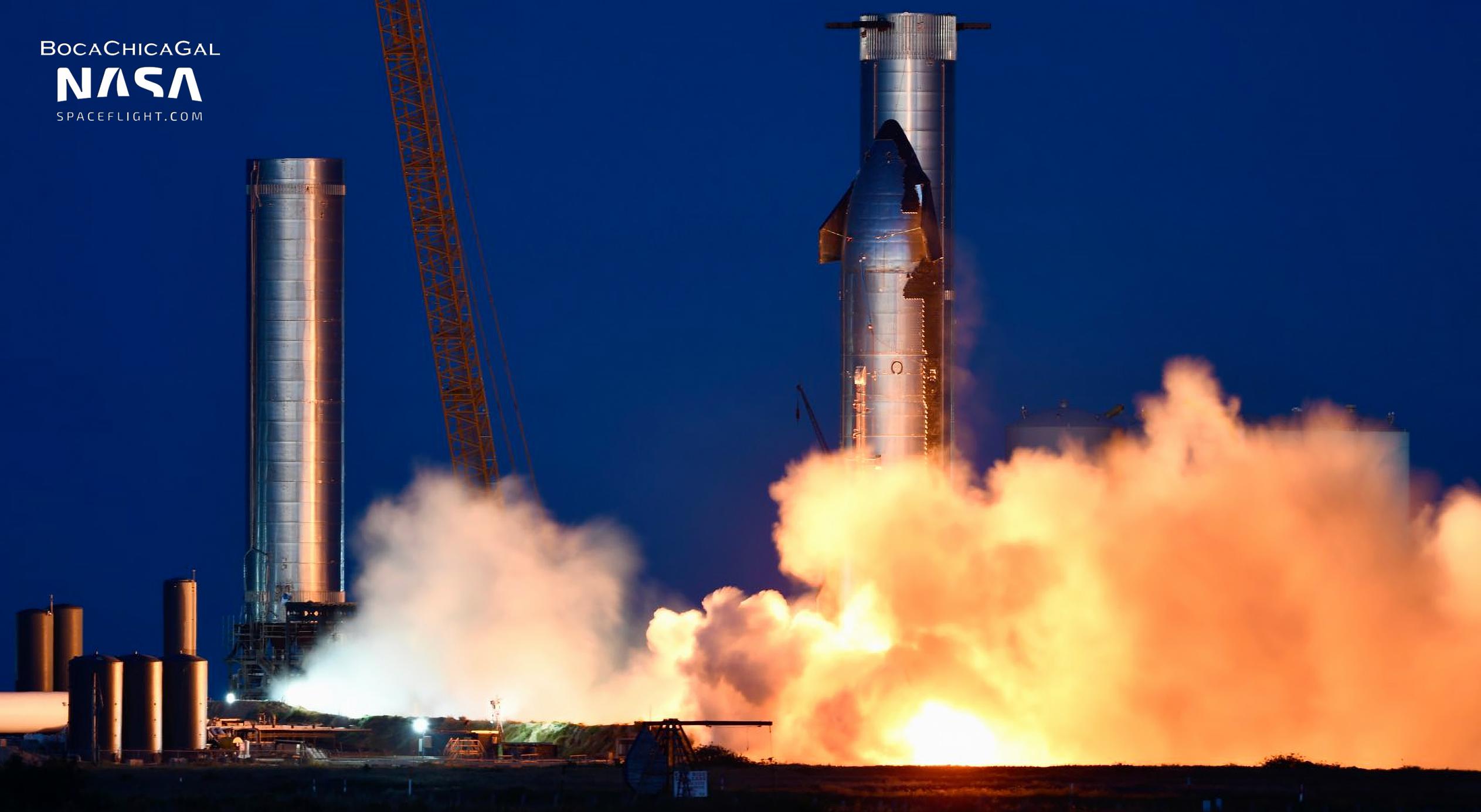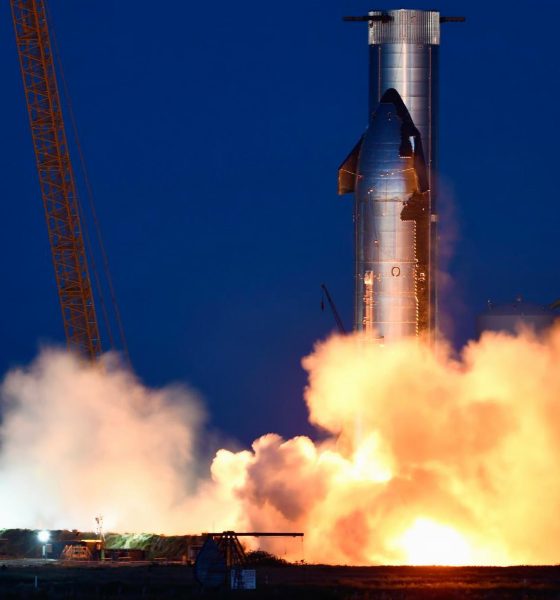

News
SpaceX Starship fires up Raptor Vacuum engine twice in one hour
After weeks of exceptionally cautious buildup, SpaceX’s first orbital-class Starship prototype has repeatedly broken new ground tests in the first few hours of its first static fire test window.
SpaceX first installed Starship S20 on one of two suborbital launch and test stands more than two months ago. After almost six weeks of largely invisible work, longer than any other new Starship prototype has spent inactive at Starbase launch facilities, Ship 20 came to life for the first time during a ‘pneumatic proof’ test completed on September 27th. Two days later, put the Starship through a complex cryogenic proof test, loading supercool liquid nitrogen instead of ambient-temperature gas and simulating the thrust of six Raptor engines with hydraulic rams.
According to CEO Elon Musk, Ship 20 passed its first ‘cryoproof’ without issue, opening the door for static fire testing with real methane and oxygen (LCH4/LOx) propellant and Raptor engines. However, for unknown reasons, it would ultimately take SpaceX more than three weeks of additional work to prepare Starship S20 for its first engine-involved test.
On October 19th, near the end of a seven-hour test window, Starship S20 sort of fired up for the first time, completing what is known as a preburner test. Effectively the first half of static fire test without full ignition, it was nevertheless the first time a Raptor Vacuum engine was operated on a Starship prototype. Originally, based on road closures scheduled with Cameron County, Texas, that preburner test and associated static fire testing was initially scheduled to begin as early as Friday, September 31st.
SpaceX continued to file for and cancel closures throughout the next week, culminating in a few local residents receiving a routine safety notice about a possible test on October 13th. That attempt was canceled soon after and SpaceX ultimately distributed alerts for tests on October 14th and October 18th. Ship 20’s first preburner test was completed on the 19th, followed by another soon-to-be-rescinded notice on the 20th.
Finally, after perhaps the windiest road yet for a Starship from cryoproof to static fire, Starship S20 sailed through a static fire test flow on October 21st and ultimately fired up for the first time ever at 7:16 pm CDT (00:16 UTC). In perfect opposition to weeks of unprecedentedly slow testing, Starship S20 not only completed its first true static fire early in the test window, but it completed the first on-vehicle static fire of a Raptor Vacuum engine and then, just over an hour later, performed a second static fire – this time simultaneously igniting both a Raptor Vacuum and Raptor Center (sea-level-optimized) engine. Aside from also marking the first time that two Raptor variants have been simultaneously fired on the same vehicle, Starship S20’s two-test surprise was technically the fastest back-to-back static fire SpaceX has ever completed, beating Starship SN9 by about 15 minutes.
Back in January 2021, SN9 completed an unprecedented three back-to-back-to-back Raptor static fires in less than 100 minutes as part of what Musk described as “[a day] about practicing Starship engine starts.” SN9 ultimately completed two of those tests in 75 minutes, setting a niche but still impressive turnaround record. Starship S20, however, managed two static fires in 62 minutes on October 21st.
With any luck, Ship 20’s unexpected first-test milestones will mark the start of a more energetic period for the orbital-class prototype, potentially building up to the first Starship static fire with more than three Raptors and the first test with all six engines installed. Super Heavy Booster 4 is also well overdue for its own proof and static fire test campaign, virtually all of which will be new territory for SpaceX.

Investor's Corner
Tesla stock closes at all-time high on heels of Robotaxi progress

Tesla stock (NASDAQ: TSLA) closed at an all-time high on Tuesday, jumping over 3 percent during the day and finishing at $489.88.
The price beats the previous record close, which was $479.86.
Shares have had a crazy year, dipping more than 40 percent from the start of the year. The stock then started to recover once again around late April, when its price started to climb back up from the low $200 level.
This week, Tesla started to climb toward its highest levels ever, as it was revealed on Sunday that the company was testing driverless Robotaxis in Austin. The spike in value pushed the company’s valuation to $1.63 trillion.
Tesla Robotaxi goes driverless as Musk confirms Safety Monitor removal testing
It is the seventh-most valuable company on the market currently, trailing Nvidia, Apple, Alphabet (Google), Microsoft, Amazon, and Meta.
Shares closed up $14.57 today, up over 3 percent.
The stock has gone through a lot this year, as previously mentioned. Shares tumbled in Q1 due to CEO Elon Musk’s involvement with the Department of Government Efficiency (DOGE), which pulled his attention away from his companies and left a major overhang on their valuations.
However, things started to rebound halfway through the year, and as the government started to phase out the $7,500 tax credit, demand spiked as consumers tried to take advantage of it.
Q3 deliveries were the highest in company history, and Tesla responded to the loss of the tax credit with the launch of the Model 3 and Model Y Standard.
Additionally, analysts have announced high expectations this week for the company on Wall Street as Robotaxi continues to be the focus. With autonomy within Tesla’s sights, things are moving in the direction of Robotaxi being a major catalyst for growth on the Street in the coming year.
Elon Musk
Tesla needs to come through on this one Robotaxi metric, analyst says
“We think the key focus from here will be how fast Tesla can scale driverless operations (including if Tesla’s approach to software/hardware allows it to scale significantly faster than competitors, as the company has argued), and on profitability.”

Tesla needs to come through on this one Robotaxi metric, Mark Delaney of Goldman Sachs says.
Tesla is in the process of rolling out its Robotaxi platform to areas outside of Austin and the California Bay Area. It has plans to launch in five additional cities, including Houston, Dallas, Miami, Las Vegas, and Phoenix.
However, the company’s expansion is not what the focus needs to be, according to Delaney. It’s the speed of deployment.
The analyst said:
“We think the key focus from here will be how fast Tesla can scale driverless operations (including if Tesla’s approach to software/hardware allows it to scale significantly faster than competitors, as the company has argued), and on profitability.”
Profitability will come as the Robotaxi fleet expands. Making that money will be dependent on when Tesla can initiate rides in more areas, giving more customers access to the program.
There are some additional things that the company needs to make happen ahead of the major Robotaxi expansion, one of those things is launching driverless rides in Austin, the first city in which it launched the program.
This week, Tesla started testing driverless Robotaxi rides in Austin, as two different Model Y units were spotted with no occupants, a huge step in the company’s plans for the ride-sharing platform.
Tesla Robotaxi goes driverless as Musk confirms Safety Monitor removal testing
CEO Elon Musk has been hoping to remove Safety Monitors from Robotaxis in Austin for several months, first mentioning the plan to have them out by the end of 2025 in September. He confirmed on Sunday that Tesla had officially removed vehicle occupants and started testing truly unsupervised rides.
Although Safety Monitors in Austin have been sitting in the passenger’s seat, they have still had the ability to override things in case of an emergency. After all, the ultimate goal was safety and avoiding any accidents or injuries.
Goldman Sachs reiterated its ‘Neutral’ rating and its $400 price target. Delaney said, “Tesla is making progress with its autonomous technology,” and recent developments make it evident that this is true.
Investor's Corner
Tesla gets bold Robotaxi prediction from Wall Street firm
Last week, Andrew Percoco took over Tesla analysis for Morgan Stanley from Adam Jonas, who covered the stock for years. Percoco seems to be less optimistic and bullish on Tesla shares, while still being fair and balanced in his analysis.

Tesla (NASDAQ: TSLA) received a bold Robotaxi prediction from Morgan Stanley, which anticipates a dramatic increase in the size of the company’s autonomous ride-hailing suite in the coming years.
Last week, Andrew Percoco took over Tesla analysis for Morgan Stanley from Adam Jonas, who covered the stock for years. Percoco seems to be less optimistic and bullish on Tesla shares, while still being fair and balanced in his analysis.
Percoco dug into the Robotaxi fleet and its expansion in the coming years in his latest note, released on Tuesday. The firm expects Tesla to increase the Robotaxi fleet size to 1,000 vehicles in 2026. However, that’s small-scale compared to what they expect from Tesla in a decade.
Tesla expands Robotaxi app access once again, this time on a global scale
By 2035, Morgan Stanley believes there will be one million Robotaxis on the road across multiple cities, a major jump and a considerable fleet size. We assume this means the fleet of vehicles Tesla will operate internally, and not including passenger-owned vehicles that could be added through software updates.
He also listed three specific catalysts that investors should pay attention to, as these will represent the company being on track to achieve its Robotaxi dreams:
- Opening Robotaxi to the public without a Safety Monitor. Timing is unclear, but it appears that Tesla is getting closer by the day.
- Improvement in safety metrics without the Safety Monitor. Tesla’s ability to improve its safety metrics as it scales miles driven without the Safety Monitor is imperative as it looks to scale in new states and cities in 2026.
- Cybercab start of production, targeted for April 2026. Tesla’s Cybercab is a purpose-built vehicle (no steering wheel or pedals, only two seats) that is expected to be produced through its state-of-the-art unboxed manufacturing process, offering further cost reductions and thus accelerating adoption over time.
Robotaxi stands to be one of Tesla’s most significant revenue contributors, especially as the company plans to continue expanding its ride-hailing service across the world in the coming years.
Its current deployment strategy is controlled and conservative to avoid any drastic and potentially program-ruining incidents.
So far, the program, which is active in Austin and the California Bay Area, has been widely successful.








